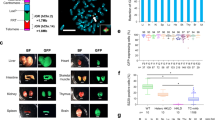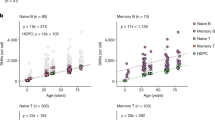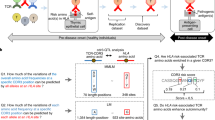Abstract
Although the genes of the major histocompatibility complex (MHC) are tightly linked, four loci (HLA-A, B, C and DR) have been defined using rare families in which antigenic specificities segregated from each other. As an alternative approach for defining loci, Kavathas et al.1 selected HLA-mutant lymphoblastoid cell lines (LCLs) that had lost expression of specific genetic markers. An HLA-GLO heterozygous LCL, LCL-721, was mutagenized with ionizing radiation which is known to induce multigenic deletions2; variants no longer expressing a specific HLA antigen were selected. While some mutants lost expression of only the antigen selected against, most simultaneously lost expression of several identifiable cis-linked gene products. Many of the multiple-loss mutants resulted from chromosome rearrangements, especially deletions1. Five new secondary B-cell (SB) antigens have recently been defined3,4, which evoke strong secondary allogeneic proliferative and cytotoxic responses. Because they resemble the HLA-DR antigens both functionally and genetically, it was not known whether they were coded for by a gene distinct from the gene(s) encoding HLA-DR. We have now characterized LCL-721 mutants for expression of both HLA-DR and SB. Of 20 lines which had lost expression of the HLA-A, -B and -DR antigens from one haplotype, four retained expression of the cis-linked SB antigen. One of these mutants had a visible deletion that included the region coding for HLA on the short arm of one chromosome 6. Because the cis-linked SB antigen continued to be expressed, the gene coding lor SB antigens must be different from that coding for HLA-DR antigens.
This is a preview of subscription content, access via your institution
Access options
Subscribe to this journal
Receive 51 print issues and online access
$199.00 per year
only $3.90 per issue
Buy this article
- Purchase on Springer Link
- Instant access to full article PDF
Prices may be subject to local taxes which are calculated during checkout
Similar content being viewed by others
References
Kavathas, P., Bach, F. H. & DeMars, R. Proc. natn. Acad. Sci. U.S.A. 77, 4251–4255 (1980).
Abrahamson, S. & Wolff, S. Nature 264, 715–719 (1976).
Shaw, S., Johnson, A. H. & Shearer, G. M. J. exp. Med. 152, 565–580 (1980).
Shaw, S., Kavathas, P., Pollack, M. S., Charmot, D. & Mawas, C. Nature 293, 745–747 (1981).
Shaw, S., Duquesnoy, R. J. & Smith, P. Immunogenetics (in the press).
Sheehy, M. J., Sondel, P. M., Bach, M. L., Wank, R. & Bach, F. H. Science 188, 1308–1310 (1975).
Weitkamp, L. & Francke, U. Cell. Genet. 22, 92–105 (1978).
Ploegh, H. L., Orr, H. T. & Strominger, J. L. Proc. natn. Acad. Sci. U.S.A. 77, 6081–6085 (1980).
Author information
Authors and Affiliations
Rights and permissions
About this article
Cite this article
Kavathas, P., DeMars, R., Bach, F. et al. SB: a new HLA-linked human histocompatibility gene defined using HLA-mutant cell lines. Nature 293, 747–749 (1981). https://doi.org/10.1038/293747a0
Received:
Accepted:
Issue Date:
DOI: https://doi.org/10.1038/293747a0
This article is cited by
-
Mapping of prolactin and tumor necrosis factor-beta genes on human chromosome 6p using lymphoblastoid cell deletion mutants
Somatic Cell and Molecular Genetics (1989)
-
A novel HLA class II molecule
Immunogenetics (1988)
-
Mapping of the class II region of the human major histocompatibility complex by pulsed-field gel electrophoresis
Nature (1986)
-
HLA-JY328: Mapping studies and expression of a polymorphic HLA class I gene
Immunogenetics (1986)
-
Refinement of HLA gene mapping with induced B-cell line mutants
Immunogenetics (1985)
Comments
By submitting a comment you agree to abide by our Terms and Community Guidelines. If you find something abusive or that does not comply with our terms or guidelines please flag it as inappropriate.



